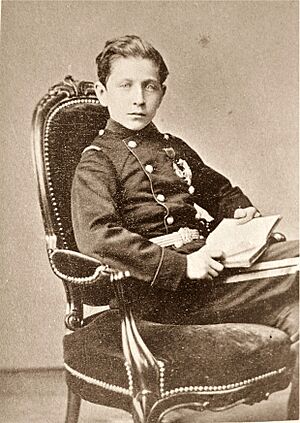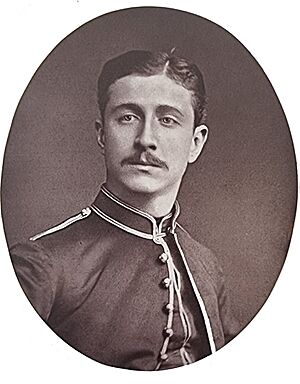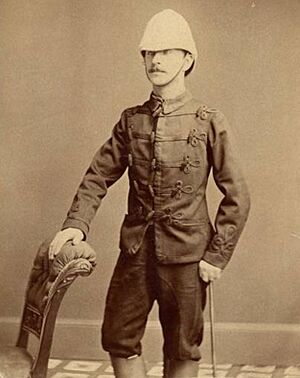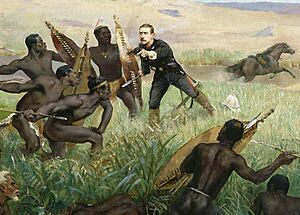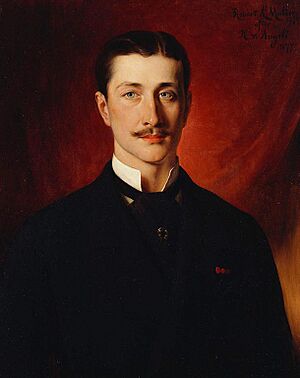Louis-Napoléon, Prince Imperial facts for kids
Quick facts for kids Louis-Napoléon |
|||||
|---|---|---|---|---|---|
| Prince Imperial of France | |||||

Louis-Napoléon in 1878
|
|||||
| Head of the House of Bonaparte | |||||
| Period | 9 January 1873 – 1 June 1879 | ||||
| Predecessor | Napoleon III | ||||
| Successor | Napoléon-Jérôme or Napoléon Victor |
||||
| Born | 16 March 1856 Tuileries Palace, Paris, French Empire |
||||
| Died | 1 June 1879 (aged 23) Sobhuza's kraal near Ulundi, Zulu Kingdom |
||||
| Burial | St Michael's Abbey, Farnborough | ||||
|
|||||
| House | Bonaparte | ||||
| Father | Napoleon III | ||||
| Mother | Eugénie de Montijo | ||||
| Religion | Roman Catholicism | ||||
| Signature | |||||
Napoléon, Prince Imperial (born Napoléon Eugène Louis Jean Joseph Bonaparte; March 16, 1856 – June 1, 1879), also known as Louis-Napoléon, was the only child of Napoleon III. His father was the Emperor of the French. His mother was Empress Eugénie.
After his father lost his throne in 1870, Louis-Napoléon and his family moved to England. When his father died in 1873, a group of people who supported the Bonaparte family, called Bonapartists, named him Napoleon IV.
In England, he trained to become an officer in the British Army. He really wanted to fight in a war. He convinced the British to let him join the Anglo-Zulu War. In 1879, while fighting with British soldiers, he was killed in a small fight with some Zulus.
His early death shocked many people across Europe. He was the last real hope for the House of Bonaparte to rule France again.
Life Story of Louis-Napoléon
Louis-Napoléon was born in Paris at the Tuileries Palace. He was baptized on June 14, 1856, at Notre Dame Cathedral. His godfather was Pope Pius IX. His godmother was Josephine, the Queen of Sweden.
His education began in 1867. General Frossard was in charge of his studies. Augustin Filon was his tutor. His English nurse, Miss Shaw, was suggested by Queen Victoria. She taught the prince English from a young age. His family called him "Loulou." In 1868, he visited Corsica. He attended a celebration there for the island joining France.
When the Franco-Prussian War of 1870–1871 started, he went with his father to the front lines. He was a sub-lieutenant. The prince was near Saarbrücken during a battle. But when the war went badly for France, his father sent him away.
His father told him to go to Belgium. From there, he traveled to England. He arrived on September 6, 1870. His parents joined him later. The Second French Empire had ended. The family settled in England at Camden Place in Chislehurst, Kent.
When his father died in 1873, the Bonapartists declared him Napoleon IV. On his 18th birthday, many people came to Camden Place to cheer for him.
The prince took physics classes at King's College London. In 1872, he was accepted into the Royal Military Academy, Woolwich. He finished seventh out of 34 students. He was best at riding and fencing. After that, he served with the Royal Artillery in Aldershot.
In the 1870s, people talked about him marrying Princess Beatrice of the United Kingdom. She was Queen Victoria's youngest daughter. Queen Victoria also thought it would be good for Europe if the prince became Emperor of France.
The prince remained a strong Catholic. He hoped that the Bonapartist cause would succeed. He believed this if the Third Republic failed. He supported Eugène Rouher's ideas. He disagreed with Prince Napoléon-Jérôme in 1876.
When the Zulu War began in 1879, the prince wanted to join. He was a lieutenant. He convinced the British military to let him go. This was despite objections from Rouher and other Bonapartists. He was only allowed to go because his mother, Empress Eugénie, asked for it. Queen Victoria also helped.
He left England on February 27, 1879. He had letters from the Duke of Cambridge. The Duke was the British commander-in-chief. He hoped the prince could follow the troops. When he arrived in Durban, he joined the General's Head-Quarters. He met Frederic Thesiger, 2nd Baron Chelmsford, the commander in South Africa, on April 9. He was officially placed on Chelmsford's staff.
The prince went with Chelmsford into Zululand. He was eager for action. Lieutenant Arthur Brigge, a friend, warned him. He told the prince "not to do anything rash." He reminded him of the Empress at home.
Chelmsford wanted to keep the prince safe. He assigned him to Colonel Richard Harrison of the Royal Engineers. Harrison was in charge of transport and scouting the route to Ulundi, the Zulu capital. Chelmsford told Harrison that the prince must always have a strong escort. Lieutenant Jahleel Brenton Carey was put in charge of him. Carey spoke French and was from Guernsey.
The prince went on several scouting missions. His eagerness almost led him into an ambush once. This happened when he went beyond orders with Colonel Redvers Buller. Despite this, on May 31, 1879, Harrison let the prince scout with a forward party. Harrison mistakenly thought the path was clear of Zulu fighters.
The Prince's Death in Battle
On the morning of June 1, 1879, the troop left earlier than planned. They did not have their full escort. This was mainly because the prince was impatient. Led by Carey, the scouts rode deeper into Zululand. Harrison and Buller were not there to stop him. The prince took command from Carey, even though Carey was higher in rank.
At noon, the prince stopped the troop at an empty kraal (a Zulu village). The prince and Carey drew some maps. They used some thatch to make a fire. No one was on lookout. As they were getting ready to leave, about 40 Zulus attacked them. They fired their weapons and rushed forward, yelling.
The prince ran to get on his horse. He grabbed the holster on his saddle. His horse then ran off before he could get on. After about 100 yards, the strap he was holding broke. The horse kicked the prince in the stomach, knocking the wind out of him. The prince fell under his horse. His right arm was trampled.
He quickly stood up. He pulled out his revolver with his left hand. He started to run, but the Zulus were faster. The prince fired three shots at his attackers, but he missed. He then fired two more shots, aiming more carefully. But these also missed.
One Zulu, named Langalibalele, threw his spear at the prince, but missed. Another spear, thrown by Zabanga, hit the prince's left shoulder. The prince tried to keep fighting. He held Langalibalele's spear in his right hand and his revolver in his left. But he was weak from his injuries. The prince fell to the ground and was overcome.
Two soldiers from the Natal Native Horse, Abel and Rogers, died with the prince. Their Zulu guide also died. Carey and the four other surviving men gathered about 50 yards away. They did not fire at the Zulus. Carey led his men back to camp. The prince's body was found the next day.
After an investigation, Carey returned to his army group. This happened after Empress Eugénie and Queen Victoria got involved. Carey died in Bombay on February 22, 1883.
Louis-Napoléon's death caused a huge stir around the world. Rumors spread in France. Some said the British had planned his death. Others blamed French republicans or the Freemasons. One story even accused Queen Victoria of arranging it all. The Zulus later said they would not have killed him if they knew who he was. Langalabalele, his main attacker, was killed in July. This happened at the Battle of Ulundi.
Eugénie later visited Sobuza's kraal, where her son died. The Prince Imperial Memorial was built there. Queen Victoria paid for it. Garnet Wolseley, 1st Viscount Wolseley, described the prince as "a plucky young man." He added, "he died a soldier's death. What on earth could he have done better?"
His body was brought back to Spithead on a British ship. Then it was moved to another ship for sailing to Woolwich Arsenal. Overnight, his body lay in state. The funeral procession, including Queen Victoria, went to Chislehurst. He was buried there. On January 9, 1888, his body was moved. His mother built a special tomb for him. This was the Imperial Crypt at St Michael's Abbey, Farnborough. He was buried next to his father.
The Prince Imperial chose Prince Napoléon Victor Bonaparte as his heir. He skipped Victor's father, Prince Napoléon.
Lasting Impact and Memory
In 1880, people in Chislehurst built a monument to the Prince Imperial. It is on Chislehurst Common near Camden Place. This monument is now a protected historical site. In the 1950s, the road by the monument was renamed Prince Imperial Road.
The Australian Rules football club Footscray was inspired by the prince's death. They renamed their club to the Prince Imperial Football Club in the early 1880s. But they changed back to Footscray two years later.
The asteroid moon Petit-Prince was named after the Prince Imperial in 1998. This is because it orbits an asteroid named after his mother (45 Eugenia).
In Books and Plays
His death is described in detail in G. A. Henty's book The Young Colonists: A Tale of The Zulu and Boer Wars (1885).
In R. F. Delderfield's novel Long Summer Day, a character named Rudd was a soldier. He failed to rescue the Prince Imperial in 1879. The main character, Paul Craddock, was born on the same day the prince died.
Emma Lazarus wrote poems called "Destiny" about the prince's birth and death.
The Italian poet Giosuè Carducci wrote a poem about him in 1879. He described the prince's death.
In the play Napoleon IV by Maurice Rostand, the prince is killed in a planned ambush. Queen Victoria is shown as being involved.
The Prince Imperial is a small character in Donald Serrell Thomas's Sherlock Holmes novel Death on a Pale Horse (2013).
Titles and Awards
| Styles of Napoléon, Prince Imperial |
|
|---|---|
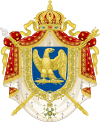 |
|
| Reference style | His Imperial Highness |
| Spoken style | Your Imperial Highness |
He was called Prince Imperial of France from the day he was born.
French Awards
- Knight Grand Cross of the Legion of Honour
Foreign Awards
 Austrian Empire: Grand Cross of the Order of St. Stephen, 1865
Austrian Empire: Grand Cross of the Order of St. Stephen, 1865 Denmark: Knight of the Order of the Elephant, March 11, 1865
Denmark: Knight of the Order of the Elephant, March 11, 1865 Mexican Empire:
Mexican Empire:
- Grand Cross of the Order of Guadalupe, 1864
- Grand Cross of the Order of the Mexican Eagle, 1865
 Kingdom of Portugal:
Kingdom of Portugal:
- Grand Cross of the Order of the Tower and Sword, 1861
- Grand Cross of the Sash of the Two Orders, 1865
 Russian Empire: Knight of the Order of St. Andrew the First-called, May 30, 1865.
Russian Empire: Knight of the Order of St. Andrew the First-called, May 30, 1865. Kingdom of Sardinia: Knight of the Order of the Annunciation, February 20, 1859
Kingdom of Sardinia: Knight of the Order of the Annunciation, February 20, 1859 Kingdom of Saxony: Knight of the Order of the Rue Crown, 1857
Kingdom of Saxony: Knight of the Order of the Rue Crown, 1857 Spain: Knight of the Order of the Golden Fleece, March 30, 1856
Spain: Knight of the Order of the Golden Fleece, March 30, 1856
 Sweden-Norway: Knight of the Royal Order of the Seraphim, June 14, 1856
Sweden-Norway: Knight of the Royal Order of the Seraphim, June 14, 1856
Images for kids
See also
 In Spanish: Napoleón Eugenio Luis Bonaparte para niños
In Spanish: Napoleón Eugenio Luis Bonaparte para niños
- Railway of the Prince Imperial


